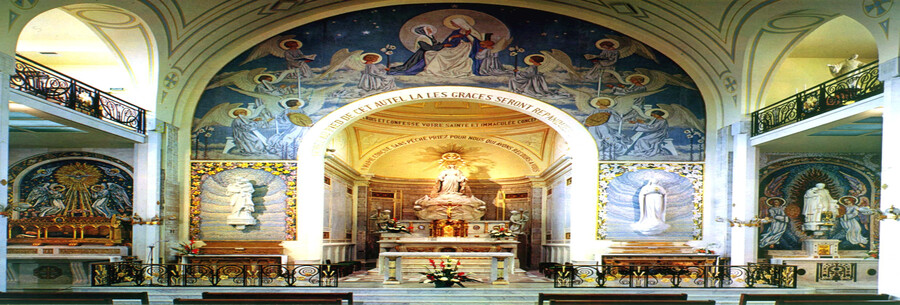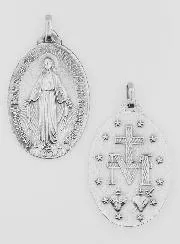The Chapelle de la Rue du Bac, located in the 7th arrondissement of Paris, is one of the most important places of pilgrimage for Catholics from all over the world. The shrine is particularly well known for the Marian apparitions experienced by Saint Catherine Labouré in 1830, which led to the creation of the Miraculous Medal. Through its history, significance and place in Marian devotion, let's discover why this chapel attracts millions of visitors every year.
History of the Chapelle de la Rue du Bac
The Chapelle de la Rue du Bac is part of the complex of the Daughters of Charity, a religious congregation founded in the 17th century by Saint Vincent de Paul and Saint Louise de Marillac. Dedicated to serving the poor and the sick, this congregation's mission was to meet the spiritual and material needs of the underprivileged. In 1813, the Daughters of Charity moved to 140 Rue du Bac, in the Parisian district of Saint-Germain-des-Prés. A novitiate was soon opened to train new sisters, and a chapel was built within the establishment. This chapel was to be the site of an extraordinary event that would forever mark the history of the congregation and Catholicism in France: the apparitions of the Virgin Mary to a young novice, Catherine Labouré.
The Apparitions of the Virgin Mary to Catherine Labouré
Catherine Labouré entered the Daughters of Charity in 1830, aged 24. She was a pious, simple and discreet young woman whose deep faith was reflected in her unconditional love for the Virgin Mary. A few months after her arrival, she received a series of Marian visions that gave rise to the famous Miraculous Medal.
The First Apparition: 18 July 1830
On the night of 18 July 1830, Catherine was awoken by a "child" whom she later identified as her guardian angel. He asked her to go to the chapel where she found the Virgin Mary sitting by the altar. Mary spoke to her at length, entrusting her with prophecies about the future of France and the Church, as well as messages of peace. Catherine listened in wonder as this heavenly figure spoke to her with tenderness and affection.
The Second Apparition: 27 November 1830
The second apparition was the one that gave birth to the Miraculous Medal. On this day, during a silent prayer, Catherine again saw the Virgin Mary. The Virgin Mary was standing with her arms open and rays of light were streaming from her hands. She is surrounded by a message in the shape of an oval: "O Mary conceived without sin, pray for us who have recourse to you." Mary asks Catherine to have a medal struck according to this image, promising that all those who wear it with faith will receive special graces.
On the reverse of the medal, Catherine sees another symbol: an "M" surmounted by a cross, beneath which are two hearts, one surrounded by thorns, representing the Sacred Heart of Jesus, and the other pierced by a sword, symbolising the Immaculate Heart of Mary. Twelve stars surround the whole, representing the apostles and the universal Church. This vision became the model for the Miraculous Medal, and Catherine passed on the Virgin's message to her confessor, Father Aladel.
The Third Apparition: December 1830
A third apparition took place in December of the same year, but it was brief and silent. This last vision confirmed for Catherine the importance of her mission to spread the medal.
The Miraculous Medal and Its Spiritual Impact
The Virgin's request was taken seriously by Father Aladel, who obtained permission to have the medal struck. In June 1832, the first medals were distributed in Paris, at a time when the city was ravaged by a cholera epidemic. Parisians soon reported miraculous cures and sudden conversions, attributed to wearing the medals. The phenomenon was so spectacular that it became known as the Médaille Miraculeuse. In just ten years, millions of medals were distributed around the world, marking a renewal of Marian devotion within the Catholic Church. The medal became a symbol of protection and grace, and its distribution intensified, accompanied by accounts of miracles.
The Chapelle de la Rue du Bac: Place of Pilgrimage
Today, the Chapelle de la Rue du Bac has become an essential place of pilgrimage. Every year, millions of people come to pray and meditate in this chapel, hoping to obtain graces or spiritual protection. Inside, the chapel is sober but luminous, and a feeling of profound peace pervades the place. The chapel has been decorated over the years to honour the memory of Saint Catherine Labouré and the Virgin Mary. A statue of the Virgin, inspired by Catherine's vision, is placed near the altar, and the various symbols on the medal can be admired. The chapel's altar is surrounded by ex-votos and devotional objects left by pilgrims in gratitude for the graces they received. The body of Saint Catherine Labouré rests in the chapel, displayed in a glass shrine, giving the faithful the opportunity to meditate before her. Her body, which has remained incorrupt since her death in 1876, is a sign of veneration for pilgrims.
Spiritual Significance and Devotion to the Chapel
For Catholics, the Rue du Bac Chapel is not only a place of prayer, but also a space for encountering the Virgin Mary. Those who come to the chapel seek comfort, protection and inspiration to face their trials. Through her apparitions to Saint Catherine Labouré, the Virgin Mary left a message of peace, faith and trust in God that continues to resonate in people's hearts. Pilgrims often receive the Miraculous Medal as a souvenir, a symbolic act of faith for those hoping to receive the graces promised by the Virgin. The chapel shop sells blessed medals, rosaries, icons and other religious objects, allowing visitors to leave with a symbol of their pilgrimage.
How to get to the Chapelle de la Rue du Bac
The Chapelle de la Rue du Bac is located at 140 Rue du Bac, in the Saint-Germain-des-Prés district, easily accessible by metro from Sèvres-Babylone station (lines 10 and 12). It is open to the public every day, and masses are celebrated there regularly. Pilgrims come from all over the world, testifying to the international appeal of this place.
La Chapelle de la Rue du Bac Today
The chapel continues to attract believers, and many visitors report finding deep spiritual peace there. The place is maintained by the Daughters of Charity, who take care to preserve the spirit of prayer and recollection. In 1947, Catherine Labouré was canonised by Pope Pius XII, confirming the spiritual value of her experience and her message for the Church. The Chapelle de la Rue du Bac remains a lively place, with thousands of pilgrims every year coming to pray and seek the grace of the Virgin Mary. For many, this place embodies the Virgin's presence in their lives and the assurance of her protection, as she promised in 1830.
The Chapelle de la Rue du Bac is a spiritual jewel of Paris, a shrine of peace and devotion where the faithful come to draw closer to the Virgin Mary. The site of Marian apparitions to Saint Catherine Labouré, it carries a universal message of grace and faith. Whether for prayer, meditation or to obtain the Miraculous Medal, the chapel is a testimony to Mary's maternal love for all her children and the power of Marian devotion.




















